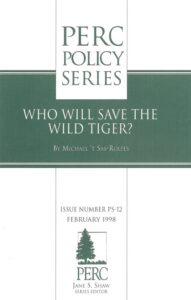DOWNLOAD THE FULL REPORT
The tiger, which once ranged throughout Asia, faces extinction in the wild. The only way to save it is to provide incentives that make people who live near tigers want to conserve them, says Michael ‘t Sas-Rolfes in a new paper, “Who Will Save the Wild Tiger?” published by PERC.
More than 100,000 tigers roamed Asia early in this century. Today, there are at most 7,300–many of them in populations too small to have long-term viability.
Tigers continue to be killed in spite of command-and-control policies such as a ban on trade in tiger parts and penalties against poaching. Although many people in the developed world are eager to donate money to protect the tiger, little of that flows to the people who live near tiger habitat, where tigers kill livestock and even people.
“Tiger conservation is ultimately a matter of incentives,” says Mr. ‘t Sas-Rolfes. “We must convert live tigers from liabilities into assets.” The conservation community has begun to recognize the importance of incentives, but it is not clear whether policies are being implemented fast enough to save the tiger in the wild.
Some of the approaches that must be considered, says ‘t Sas-Rolfes, include expanding tiger-based tourism, allowing limited trophy hunting, encouraging private purchases of land for tiger preserves, and possibly permitting regulated commercial tiger farming.
‘t Sas-Rolfes is a conservation economist based in Johannesburg, South Africa. He has previously written about ways to protect the elephant and the rhinoceros. He is the author of Rhinos: Conservation, Economics and Trade-Offs (Institute of Economic Affairs, London).
Download the full report, including endnotes and references.




